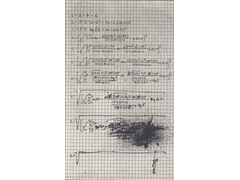liam.mccaffrey
|
| posted on 18/8/09 at 06:42 PM |

|
|
Projectile Motion
I thought I was good at projectile motion but this question has stumped me. Not looking for a solutions but a clue to the method.
My brain has gone on vacation, any ideas
Supplied info is Range=6m, angle of inclination=60 deg
a, work out total time in flight (for 13 marks)
b, work out initial speed u for (8 marks)
c, work out max height for (5 marks)
Build Blog
Build Photo Album
|
|
|
|
|
blakep82
|
| posted on 18/8/09 at 06:48 PM |

|
|
don't you need to know the velocity?
actually, if you know the range & angle, and gravity is contant, you should be able to work out its speed. or is that average speed? then you
should be able to do its time in flight, and max height should be easy enough since its only 5 points :p
i don't know, i've not done any maths since school, some 9 years ago
edit:
erm, no, coz the height and therefore flight time is dependant on the speed
[Edited on 18/8/09 by blakep82]
________________________
IVA manual link http://www.businesslink.gov.uk/bdotg/action/detail?type=RESOURCES&itemId=1081997083
don't write OT on a new thread title, you're creating the topic, everything you write is very much ON topic!
|
|
|
roadrunner
|
| posted on 18/8/09 at 06:48 PM |

|
|
That's so totally easy that is. 
|
|
|
matt_claydon
|
| posted on 18/8/09 at 06:56 PM |

|
|
Some hints without giving you an answer!:
* The initial velocity has components uSin60 and uCos60.
* The projectile lands when it has completed 6m horizontally (at constant horizontal speed). You can work out the time this takes in terms of u.
* v=u+at
* At the top of the arc the vertical component of velocity is zero. This happens at half the total time in flight.
All assuming no air resistance of course. Then it gets more fun!
|
|
|
minitici
|
| posted on 18/8/09 at 06:59 PM |

|
|
 
solution
|
|
|
nstrug
|
| posted on 18/8/09 at 07:01 PM |

|
|
Write two equations of motion for the x and y directions. In the x direction you have constant speed, in the y direction you have acceleration at -g.
Your initial speeds for the two equations are the components of the initial velocity.
Solve these equations to find your initial velocity. The rest will follow.
Remembering that cos 60 = 1/2 and sin 60 = sqrt (3)/2 makes life even easier 
Nick
Nick
|
|
|
liam.mccaffrey
|
| posted on 18/8/09 at 07:01 PM |

|
|
the problem is mat that I know all that have been through all the maths as mentioned above and I still can't get it
I am not going to disclose my qualifications it would be too emarassing 
[Edited on 18/8/09 by liam.mccaffrey]
Build Blog
Build Photo Album
|
|
|
liam.mccaffrey
|
| posted on 18/8/09 at 07:44 PM |

|
|
sorted now, was making a really stupid mistake!!!!! Thanks chaps
Build Blog
Build Photo Album
|
|
|
MikeR
|
| posted on 18/8/09 at 08:22 PM |

|
|
Well come on, tell us the answer!
|
|
|
liam.mccaffrey
|
| posted on 18/8/09 at 08:35 PM |

|
|
well i reckon the initial velocity u is 8.24m/s and the total flight time is 1.46s
and height is 2.61m???
[Edited on 18/8/09 by liam.mccaffrey]
Build Blog
Build Photo Album
|
|
|
lexus
|
| posted on 18/8/09 at 09:42 PM |

|
|
Good. Now can we get back to posts written in English. Thanks!
|
|
|













